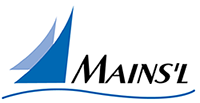SAFETY, RISK MANAGEMENT AND RIGHT TO KNOW
Mains’l is committed to a safe and healthy working environment for all employees, persons receiving services and stakeholders.
Mains’l will comply with occupational safety and health standards or rules as stipulated by 29 CFR 1910 OSHA Federal General Industry Regulations and Department of Labor and Industry OSHA state laws and rules.
(Right to Know) Mains’l neither manufactures, stores, transfers or disposes of any hazardous materials.
Mains’l has policies and procedures on blood borne pathogens which provide for infection control through procedures for cleaning and disinfecting, glove use, use of protective barriers, medical sharps, hand washing and laundry.
The agency’s infection control plan is designed to prevent illness and disease through universal precautions and availing HBV vaccine to any new or current employee at no cost to the employee.
Mains’l also has an exposure control plan for its employees which include testing by a medical provider.
For occupational safety Mains’l follows the basic tenants of the AWAIR program. AWAIR is an acronym for A Workplace Accident and Injury Reduction Program. This program is designed to identify potential causes of injuries and accidents and to eliminate those from the workplace wherever possible.
Occupational safety is everyone’s responsibility. According to OSHA, an overwhelming majority of workplace accidents are due to unsafe acts and workplace conditions. Each employee is responsible for:
- Observing safety and health rules
- Recognizing and reporting observed exposures to injury or illness
- Reporting all accidents and injuries immediately, and
- Participating in safety and risk management programs and training
The AWAIR Program is intended to:
- Establish an executive policy statement (we’re committed to safety)
- Develop strategies to reduce workplace accidents and injuries
- Provide for the safety inspection of worksites
- Establish enforcement strategies to insure compliance
- Provide for a training program (blood borne pathogens)
- Provide for the assessment and control of hazards
Strategies to reduce workplace accidents and injuries
Once each year; CRS sites will conduct an exercise to list together 3-4 workplace conditions or behaviors that can cause accidents and/or injuries. In turn the supervisor will elicit solutions from the participants to address these conditions or behaviors. The results will be sent to the vice president of administration for review and any follow up action necessary.
Inspections of Work Sites
Home Safety Inspection Checklists will be used by CRS site staff to identify potential conditions that might also cause accidents or injuries. These checklists are to be completed once every two months and sent to the vice president of administration for review and any follow up actions necessary.
Enforcement Strategies
Employees who fail to follow safety rules or requirements will be subject to employee discipline as described in HR policies.
Training:
The primary training for safety in the workplace is blood borne pathogens. Otherwise CRS sites will acquaint employees with local safekeeping practices.
Assessment and Control of Hazards
Mains’l prohibits use and storage of hazardous materials.
Safety Coordinator
The safety coordinator for Mains’l is the vice president of administration.
References
29 CFR 1910 OSHA General Industry Regulations
Department of Labor and Industry OSHA Laws and Rules (MSA Chap. 182)
Infection Control Plan
Exposure Control Plan
Cleaning and Disinfectant Procedures
Glove Procedures
Handwashing Procedures
Laundry Procedures
Protective Barrier Procedures
Sharps Procedures
Risk Exercise
Home Safety Checklist
Home Safety Checklist Calendar
Training PowerPoint
- Printer-friendly version
- Log in to post comments
